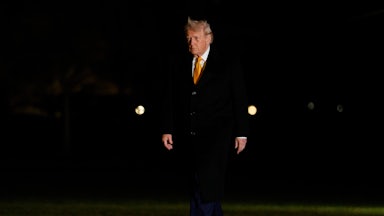When the Supreme Court struck down the Biden administration’s student debt relief order in June, the justices did so at least in part because nobody had ever done anything like the order before. To cancel more than $400 billion in student debt, the Biden administration had cited the 2003 HEROES Act, which gave the secretary of education broad authority to “waive or modify” student loan provisions during a national emergency.
That broad language did not allow the administration to act, the court’s conservative majority concluded, because it was simply too novel. “The secretary has never previously claimed powers of this magnitude under the HEROES Act,” Chief Justice John Roberts wrote on the 6–3 majority’s behalf. “As we have already noted, past waivers and modifications issued under the Act have been extremely modest and narrow in scope.” Now future waivers and modifications must be similarly constrained—even though the statute’s text says otherwise.
It is indisputable that the Supreme Court has taken a sharp right turn in recent years from an ideological perspective. But the court is also increasingly conservative in a more anodyne sense: hostile to innovative applications of existing laws, skeptical of assertions of new statutory powers, and unyielding when it comes to using old laws to solve new problems.
The court’s turn against creative policymaking can be partially traced to the rise of the major questions doctrine. This relatively new credo holds that new federal rules and regulations are presumptively invalid if an agency uses vague statutory language to address a “major” public policy issue. The court had historically given federal agencies broad latitude when crafting rules and regulations from vague federal laws, but no longer. “We expect Congress to speak clearly when authorizing an agency to exercise powers of vast economic and political significance,” the conservative majority declared in an unsigned opinion that overturned the Centers for Disease Control and Prevention’s eviction moratorium in 2021.
The court often frames the major questions doctrine as a way to protect Congress’s legislative authority from the perils of executive branch overreach. Critics of the doctrine, of which there are many, have argued that it essentially gives the Supreme Court a freestanding veto over vast sections of public policy. What counts as speaking “clearly”? What counts as an issue of “vast economic and political significance”? That is apparently for the justices to know and the rest of us to find out.
Beyond the legal reasoning itself, at the heart of the doctrine is a hostility to using old powers in new ways. In 2014’s Utility Air Regulatory Group v. EPA, one of the first cases to utilize the argument that would later become the major questions doctrine, the court rejected the Environmental Protection Agency’s conclusion that all greenhouse gases counted as pollutants under one provision of the Clean Air Act, even though the justices had previously upheld that interpretation in another part of the landmark anti-pollution law in 2007.
“Despite its textual plausibility, we noted [in Utility Air] that the Agency’s interpretation would have given it permitting authority over millions of small sources, such as hotels and office buildings, that had never before been subject to such requirements,” Roberts later wrote in the 2022 case West Virginia v. EPA, which cemented the doctrine as a key tool in the court’s statutory analysis.
In other words, even though the agency had fairly read its own powers under the statute, the court nonetheless rejected the new rule because it was doing so in a new way. “We declined to uphold EPA’s claim of ‘unheralded’ regulatory power over ‘a significant portion of the American economy,’” the chief justice explained. He then applied that reasoning in the 2022 case to block the EPA from regulating carbon emissions from coal-fired power plants under a moribund Obama-era climate policy.
The Supreme Court’s anti-novelty mindset is not limited to the EPA. In January of last year, the court also overturned an emergency rule by the Occupational Safety and Health Administration that would have required most employers in the United States to regularly test their unvaccinated employees for Covid-19. The court, which interpreted this to be a vaccine mandate for most American workers, rejected it out of hand.
“It is telling that OSHA, in its half century of existence, has never before adopted a broad public health regulation of this kind—addressing a threat that is untethered, in any causal sense, from the workplace,” the court explained in an unsigned majority opinion. “This lack of historical precedent, coupled with the breadth of authority that the secretary [of labor] now claims, is a telling indication that the mandate extends beyond the agency’s legitimate reach.”
Left unstated by the court was the basic fact that OSHA, which was founded in 1971, did not exist the last time the United States faced a pandemic like Covid. That the agency sought to use its long-standing authority to confront a new threat counted against it. Public health victories of the last century had, paradoxically, made it harder to confront a global pandemic in this one.
While this trend is most apparent when the court is dealing with new federal rules and regulations, the conservative majority’s aversion to new things extends far beyond what it describes as “the administrative state.” Last year’s ruling in New York State Rifle & Pistol Association v. Bruen, a major Second Amendment case, extended that trend to constitutional law as well. The court struck down New York’s licensing regime for concealed-carry permits and announced a new test for reviewing state laws that may violate an individual’s right to bear arms.
“To justify its regulation, the government may not simply posit that the regulation promotes an important interest,” Justice Clarence Thomas wrote for the court. “Rather, the government must demonstrate that the regulation is consistent with this Nation’s historical tradition of firearm regulation. Only if a firearm regulation is consistent with this Nation’s historical tradition may a court conclude that the individual’s conduct falls outside the Second Amendment’s unqualified command.” Thomas is vague as to what counts as “historical tradition,” what doesn’t, where it can be found, and even whether it can be best uncovered when the Second Amendment was ratified in 1791 or when the Fourteenth Amendment applied it to the states in 1868.
Bruen’s history-and-tradition test is the apotheosis of originalism, which contends that the Constitution can only be interpreted based on the “original public meaning” of its text when it was enacted. The test essentially commands lower court judges to find a founding-era analogue for any challenged state or federal gun restriction. If no such analogue existed in the early republic, then the restriction must be overturned.
This approach reflects the conservative legal movement’s preferred method of interpreting the Constitution. It is also leading to eye-opening outcomes in the lower courts. A federal judge has used the Bruen test to strike down a federal law that prohibits people with felony convictions from owning firearms, concluding that the postrevolutionary generation did not go that far. Another has uncomfortably pointed to restrictions to nineteenth-century laws that deprived Black and Native Americans of gun ownership.
In at least one instance, a federal judge ruled that a ban on gun ownership for people convicted of domestic violence could not survive Bruen. The Supreme Court will review that ruling in its next term, which begins in October. If the justices faithfully apply Bruen, it is hard to see how they can reach any conclusion other than striking down the law. The concept of “domestic violence” was an alien one to the founding generation, and the court cannot lean on Americans’ moral growth over the last two centuries to overcome that hurdle in the history-and-tradition test. A coalition of domestic violence prevention groups urged the justices in April to overturn that ruling, warning that the stakes “are literally life or death.”
This is not to say that the Supreme Court is now hostile to all forms of innovative legal reasoning. In 2021, most of the conservative justices—with the notable exception of the chief justice—signed off on a Texas law that used procedural trickery to effectively ban abortion in a way that prevented the federal courts from reviewing the law.
Nor is it to say that the court is particularly friendly to long-standing interpretations of federal law. In Sackett v. EPA, the court overturned a bipartisan interpretation of the Clean Water Act to remove vast amounts of the nation’s wetlands from the EPA’s jurisdiction. “It would be odd indeed if Congress had tucked an important expansion to the reach of the CWA into convoluted language in a relatively obscure provision concerning state permitting programs,” Justice Samuel Alito wrote for the majority, sidestepping considerable evidence that Congress intended to do just that.
The through line here is a hostility to novel forms of policymaking—and almost always progressive policymaking—by the elected branches of government on climate change, gun violence, and other issues. When the justices return from their summer break in October, they will consider other innovations like the Consumer Financial Protection Bureau’s appropriations structure and whether Congress can enact a federal wealth tax. Wherever novelty is concerned, it’s hard to expect anything but the same old, same old from the court.






